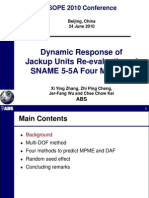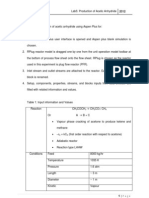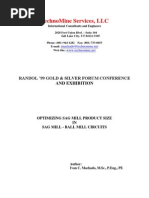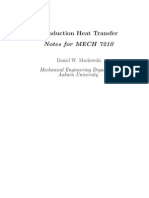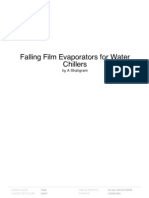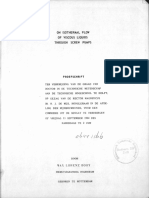Dynamic Modeling of A Batch Bioreactor For Trans-Esterification of Waste Vegetable Oil
Dynamic Modeling of A Batch Bioreactor For Trans-Esterification of Waste Vegetable Oil
Uploaded by
aremunabeel5895Copyright:
Available Formats
Dynamic Modeling of A Batch Bioreactor For Trans-Esterification of Waste Vegetable Oil
Dynamic Modeling of A Batch Bioreactor For Trans-Esterification of Waste Vegetable Oil
Uploaded by
aremunabeel5895Original Title
Copyright
Available Formats
Share this document
Did you find this document useful?
Is this content inappropriate?
Copyright:
Available Formats
Dynamic Modeling of A Batch Bioreactor For Trans-Esterification of Waste Vegetable Oil
Dynamic Modeling of A Batch Bioreactor For Trans-Esterification of Waste Vegetable Oil
Uploaded by
aremunabeel5895Copyright:
Available Formats
Dynamic Modeling of a Batch
Bioreactor for Trans-esterification of
Waste Vegetable Oil
Nabeel Adeyemi
Department of Mechanical Engineering,
Faculty of Engineering,
International Islamic University Malaysia
Malaysia
Supervisor: Prof A.K.M. Mohiuddin (Mechanical Eng Dept, IIUM),
Co-Supervisor: Assoc.Prof Dr Tariq Jameel (Biotechnology
Engineering Dept, IIUM)
Objectives
This primary aim is this work is to model the
transesterification of waste cooking oil (WVO)
using Computational Fluid dynamics (CFD)
techniques where reaction and flow in a reactor
are simultaneously considered
Introduction
Biodiesel Production based on Food Oils.
Fuel vs Food debate
Alternative raw material
WCO-thermally-degraded Food Oils
(>17hrs domestic/ industrial use at 60-90C or more).
Introduction (Contd)
Factor affecting biodiesel production
temperature, ratio of alcohol to oil,
catalyst type and amount, FFA and
water content and mixing intensity
Optimization of biodiesel production
carried out in lab flask accounting
ONLY for the kinetics related effect.
Problem Statement
Yield in WCO transesterification is about
80-85% in batch reactors due to mass
transfer and kinetics-related limitations.
The reason alluded to this is with little
reference to physical condition of
reactor, where the mixing of the
reactant can be significantly improved
during the reaction
RESEARCH PHILOSOPHY
If the hydrodynamics in bioreactor are
considered and accounted for, along
the reaction kinetics, reaction
parameters can be easily optimized for
varying process condition in reactor
design using CFD (Multiphysics
approach)
Coupled multiphysics
phenomena
Momentum
(Navier-Stokes Equations)
Energy
(Convection and Conduction, Heat transfer)
Mass
(Convection and Diffusion, Reaction)
Velocity, pressure
Temperature
Density, viscosity
Thermal conductivity
Heat capacity
Reaction rate
reaction rate
Concentration
1
2
3
Previous Milestone
Concluded WVO transesterification using
Taguchi L9 orthogonal array design
Formulated a kinetic model for the reaction
Simulated the flow in 2 D axi-symmetrical mode
METHODOLOGY
Kinetic model
Nonlinear regression (Least square fitting method)
CFD simulation-Multiple Reference frame (MRF)
model 3D
(RANS k-e, RSM and LES) turbulent models
Exploitation of P.I.V. measurements:
data analysis (RANS k-e, RSM and LES) turbulent
models
Results
Kinetic Model for Transesterification
TRI + OH<->DG + ES (1)
r1f=k1f*[TRI]*[OH]; r1r=k1r*[DI]*[ES]
d[TRI]/dt= k1f*[TRI]*[OH]-k1r*[DI]*[ES]
DG + OH <->MG + ES (2)
r2f=k1f*[DI]*[OH] r2r=-k1r*[MG]*[ES]
d[DI]/dt = =k1f*[TRI]*[OH]-k1r*[DI]*[ES]-k2f[DG][OH]+k2r*[MG]*[ES]
MG +OH <->tr + ES (3)
r3f=k3f*[MG]*[OH], r3r=k3r*[tr]*[ES]
d[MG]/dt = =k3f*[MG]*[OH]-k3r*[tr]*[ES]+k2f[DG]*[OH]-k2r*[MG]*[ES]
d[ES]/dt = k1f*[TRI]*[OH]-k1r*[DI]*[ES]]-k2f[DG][OH]+k2r*[MG]*[ES]+k3f*[MG]*[OH]-
k3r*[tr]*[ES]
With initial value of TG=0.49746, DG=0.82212, MG=0.08876, GLY=0.01378
Equation 1-3 solved
Select Initial value for preliminary fitting
specie concentration(TG, DG, MG)
k values
Compare between the experimental data and the
kinetic model
estimated using non linear regression by
minimizing the standard
Effect of impeller type, position and speed on
yield: Rushton Impeller
Figure 2: FAME wt (%) at (a) 60 (b) 65 (c) 70 C for N = 600, 650, 700 rpm and
IBC = 20, 25, 30 mm for Rushton impeller in baffled reactor
Figure 3: FAME wt (%) at (a) 60 (b) 65 (c) 70 C for N = 600, 650, 700 rpm and IBC = 20, 25, 30 mm
for Rushton impeller in unbaffled reactor
Effect of impeller type, position and speed on
yield: Elephant ear Impeller
Figure 4: FAME wt (%) at (a) 60 (b) 65 (c) 70 C for N = 600, 650, 700 rpm and IBC = 20, 25, 30 mm for Elephant
Ear impeller in baffled reactor
Figure 5: FAME wt (%) at (a) 60 (b) 65 (c) 70 C for N = 600, 650, 700 rpm and IBC = 20, 25, 30 mm
for Elephant Ear impeller in unbaffled reactor
Table 2: S/N ratio of yield
Temp(
C)
Speed (rpm)
IBC
(mm)
Rushton
unbaffled
S/N ratio
Elephant Ear
(Baffled)
S/N ratio
60 600 20 38.86 39.25
60 650 25 39.20 39.37
60 700 30 39.09 39.22
65 600 25 39.05 39.23
65 650 30 39.10 39.23
65 700 20 38.86 39.00
70 600 30 39.25 39.11
70 650 20 39.05 39.18
70 700 25 39.12 39.31
Linear relationship of temperature, speed and
Impeller bottom distance
60 65 600 650 20 25
Yield using Rushton Impeller
39.0624 0.0146t 0.0604t 0.0111S 0.0509S 0.1387I 0.0578I = + +
60 65 600 650 20 25
Yield using Elephant ear Impeller
39.06 0.13t 0.12t 0.29S 0.07S 0.27I 0.21I = + +
(1)
(2)
Table 3: Statistical correlation of temperature; Speed and IBC to yield
and peak yield time
Rushton (Peak Yield time) Elephant ear (Peak Yield time)
SE Coeff T p SE Coeff T p
Constant 2.07 9.13 0.01 0.42 218.57 0
T 3.83 2.05 0.18 0.77 -0.57 0.63
S 3.83 -1.74 0.22 0.77 -0.72 0.55
IBC 3.83 -2.74 0.11 0.77 1.34 0.31
T*S 5.74 -2.49 0.13 1.16 1.4 0.30
T*ID 5.74 0.87 0.48 1.16 -0.82 0.50
S*IBC 5.74 1.87 0.20 1.16 -0.03 0.98
p-value < 0.05 for all parameters
Non
parametric
model
Figure 5: surface plot of FAME weight yield as function
of peak yield time and temperature
60
65
70
5
10
15
400
410
420
430
440
450
temp (C)
peak yield time (min)
F
A
M
E
w
t
(
g
)
415
420
425
430
435
440
445
3
0
2
5
2
0
1
5
1
0
5
peak yield tim
e (m
in)
60
61
62
63
64
65
66
67
68
69
t
e
m
p
(
C
)
350
350
360
360
370
370
380
380
390
390
400
400
410
410
F
A
M
E
w
t
(
g
)
F
A
M
E
w
t
(
g
)
Figure 6: surface plot of FAME peak yield time as a
function of IBC distance and speed
20
25
30
600
620
640
660
680
700
0
5
10
15
20
25
30
35
speed (rpm)
distance (mm)
p
e
a
k
y
i
e
l
d
t
i
m
e
(
m
i
n
)
5
10
15
20
25
30
600
650
700
20
22
24
26
28
30
4
6
8
10
12
14
16
speed (rpm)
distance (mm)
p
e
a
k
y
i
e
l
d
t
i
m
e
(
m
i
n
)
5
6
7
8
9
10
11
12
13
14
15
Figure 7: surface plot of FAME weight yield as a function of
temperature and speed
600
620
640
660
680
700
60
65
70
350
360
370
380
390
400
410
temperature (C)
speed (rpm)
F
A
M
E
w
t
(
g
)
355
360
365
370
375
380
385
390
395
400
405
60
62
64
66
68
70
600
650
700
400
410
420
430
440
450
speed (rpm)
temp (C)
F
A
M
E
w
t
(
g
)
410
415
420
425
430
435
440
445
PIV
Reactor Property Dimension
impeller bottom clearance, C (mm) 0.11T-0.27T
Height, H (mm) 150
Tank diameter, T (mm) 130
Total Liquid Height, L (mm) 0.34T
Impeller Diameter, D (mm) 0.23T
Table 1: Physical dimension of biodiesel Reactor
RESULTS (Contd)
Figure 1. Simulated mean tangential, radial and axial velocity at impeller
bottom clearance, C= 0.11T, 0.15T, 0.19T, 0.23T and 0.27T for unbaffled
Figure 2: Time average velocity field (m/s) for full tank using Rushton
Impeller (unbaffled)
Figure 3: Time average velocity field (m/s) for full tank using Rushton
Impeller (unbaffled)
0
0.2
0.4
0.6
0.8
1
1.2
1.4
1.6
1.8
2
0.1 0.0 0.8 0.9 1.0
r/D
U
/
U
m
a
x
(
m
/
s
)
K-E
LES
RSM
PIV
Figure 4: Comparison of mean Tangential velocity for
RAN (k-e), LES, RSM models at 30 mm from shaft centre
Physical Model
Bioreactor with Rushton Impeller
0 100 200 300 400 500 600 700 800 900 1000 1100 1200 pix
0
100
200
300
400
500
600
700
800
900
1000
pix
Statistics vector map: Vector Statistics, 3931 vectors (1209)
Size: 12801024 (0,0)
Figure 5: Velocity (vectors) of stirred flow with
20m PSP using Rushton impeller at 600 rpm
0 100 200 300 400 500 600 700 800 900 1000 1100 1200 pix
0
100
200
300
400
500
600
700
800
900
1000
pix
Statistics vector map: Vector Statistics, 3931 vectors (1209)
Size: 12801024 (0,0)
Figure 6: Time average velocity field (m/s) for full tank using
Elephant Ear (unbaffled) (a) CFD (b) PIV
Figure 8: Time average velocity field (m/s) for full
tank (a) CFD (b) PIV
Conclusion
Goals achieve
Effect impeller on FAME yield
Non-parametric model using temperature, speed and
bottom distance to model FAME yield and peak time
PIV evaluation of the velocity structure by Rushton and
Elephant ear
Local rate of energy dissipation
Future Thrust
PIV resolution to determine kolmorogov scale
for spatial variability of parameter during mixing
(macro,meso, or micro) mixing
Time average shearing field (s-1) computed by
Local rate of energy dissipation
Coupling of reaction and flow model
Thank you
.u 0 V =
T
u
(u. )u . I+ ( u ( u) ) F p
t
q
c
( + V = V V + V +
c
Governing Equations
For the fluid flow, the governing equations (continuity and momentum)
for incompressible flow were used;
F is source term dependent on the velocity component and u is
the absolute velocity, which can be calculated by
The variables velocity and stress variables are decomposed into time average
and fluctuating component which are substituted into the governing equations
for incompressible flow to give the RANS
to the momentum equation called the Reynolds stress tensor
Decomposing the variables in Navier-Stokes equation yields an additional term,
i j
u u
' '
( )
u r v e = +
r ur r r
TURBULENT MODEL
This gives a system of equations of 13 unknown variables and 9 equations and is
therefore not closed
2
3
j
i
i j t ij
j i
u
u
u u
x x
o k
| |
c
c
' ' = + |
|
c c
\ .
The closure of the Reynolds stress term results in the development of turbulence
models such as the standard k-e, RNG k-e, realizable k-e and Reynolds stress models
Relationship between the Reynolds stresses to the mean flow velocity gradients
and can be expressed as
2
t
k
C
c
=
( )
2
1
. U. = U U.
2
T
T
T
t
q
k
q k k q c
o
k
c
V + V + V V + V
c
(
| |
| |
(
| |
\ .
( \ .
( )
( )
2 2
1
. U. = U U.
1 1
2
T
T
C C
T
t
c
q
c c c
q c c q
c c
o k k
c
V + V + V V + V
c
(
| |
(
|
( \ .
k the turbulent kinetic energy, defined as
1
2
i j
u u k
' '
=
1 2
1.3, 1, 1.44, 1.92, 0.09
k
C C C
c c c
o o = = = = =
Cylindrical Coordinates
( )
r
r r
r
r
z
r r
r
r
g
V
r z
V V
r
rV
r r r
r
P
z
V
V
r
V V
r
V
r
V
V
t
V
u u
u
u u
+
(
c
c
c
c
+
c
c
+
|
.
|
\
|
c
c
c
c
+
c
c
=
|
|
.
|
\
|
c
c
+
c
c
+
c
c
+
c
c
2 2
2
2
2
2
2
2 1 1
z
z z z z
z
z z
r
z
g
z
V V
r r
V
r
r r z
P
z
V
V
V
V
r
V
V
t
V
u
+
(
c
c
+
c
c
+
|
.
|
\
|
c
c
c
c
+
c
c
=
|
.
|
\
|
c
c
+
c
c
+
c
c
+
c
c
2
2
2
2
2
1 1
( )
u
u u
u
u u u u u u
u u
u u
g
V
r z
V V
r
rV
r r r
P
r z
V
V
r
V V V
r
V
r
V
V
t
V
r
z
r
r
+
(
c
c
+
c
c
+
c
c
+
|
.
|
\
|
c
c
c
c
+
c
c
=
|
.
|
\
|
c
c
+ +
c
c
+
c
c
+
c
c
2 2
2
2
2
2
2 1 1
1
Centrifugal force
Coriolis force
You might also like
- The Hundred-Page Machine Learning Book - Andriy BurkovDocument16 pagesThe Hundred-Page Machine Learning Book - Andriy BurkovKlepsusNo ratings yet
- Heriot Watt Meng Question PaperDocument34 pagesHeriot Watt Meng Question PaperRizwanPiyalNo ratings yet
- Clarinet Reed Functionality, Adjustment, and CareDocument8 pagesClarinet Reed Functionality, Adjustment, and CareMichael Emmert100% (3)
- Enm200 - Subsurface: Faculty: School: CourseDocument10 pagesEnm200 - Subsurface: Faculty: School: Courseqwertyyyy1111100% (1)
- Cooling Water Treatment Basic CalculationsDocument52 pagesCooling Water Treatment Basic CalculationsAngga Indriawan67% (3)
- Cat C280-12 Spec SheetsDocument16 pagesCat C280-12 Spec SheetsThan Htet100% (1)
- CW SampleDocument22 pagesCW SampleLaurence Sarmiento86% (7)
- MIKE21BW Step by Step GuideDocument120 pagesMIKE21BW Step by Step GuidetaufiqsuhartoNo ratings yet
- OpenFOAM WingmotionDocument81 pagesOpenFOAM WingmotionMason925No ratings yet
- Development of Francis Turbine Model WitDocument10 pagesDevelopment of Francis Turbine Model Witclaudio.ferreirademoNo ratings yet
- Submission of Term Work': Subject - CpmsDocument25 pagesSubmission of Term Work': Subject - CpmsPrakharNo ratings yet
- MixDocument19 pagesMixfreakameNo ratings yet
- Dynamic Behavior of Jack-Up ISOPE10Document36 pagesDynamic Behavior of Jack-Up ISOPE10Imran Siddiqui100% (1)
- Flow and Turbulence Structures in The Wake of A Simplified Car Model (Ahmed Model)Document8 pagesFlow and Turbulence Structures in The Wake of A Simplified Car Model (Ahmed Model)Havya VethaNo ratings yet
- Model Based Optimization of Drilling Fluid Density and ViscosityDocument34 pagesModel Based Optimization of Drilling Fluid Density and ViscositySai KumarNo ratings yet
- SaponificationDocument35 pagesSaponificationsemanasemana80% (5)
- Pocket Formula GuideDocument68 pagesPocket Formula GuideMike StevensonNo ratings yet
- Homework: 4: AnswerDocument9 pagesHomework: 4: AnswerRobel TeweldeNo ratings yet
- Variables Levels 1 2 3 Temperature, T (°C) 60 65 70 Impeller Speed, S (RPM) 600 650 700 Impeller, IBC (MM) 20 25 30Document4 pagesVariables Levels 1 2 3 Temperature, T (°C) 60 65 70 Impeller Speed, S (RPM) 600 650 700 Impeller, IBC (MM) 20 25 30aremunabeel5895No ratings yet
- Mitigation Stick SlipDocument6 pagesMitigation Stick SlipCarlos SensanoNo ratings yet
- Lab 5 Full ReportDocument9 pagesLab 5 Full Reporttirahanafi100% (1)
- Analytical Design of Radial Turbine Design-NasaDocument162 pagesAnalytical Design of Radial Turbine Design-Nasamrbookani100% (1)
- 2011-OMAE2011 JaouenKoopVaz RollDampingDocument12 pages2011-OMAE2011 JaouenKoopVaz RollDampingKelvin XuNo ratings yet
- 144 0067Document4 pages144 0067Antony BanderasNo ratings yet
- Chapter 5 - Wastewater Collection and Removal ExamplesDocument13 pagesChapter 5 - Wastewater Collection and Removal ExamplesÅdän Ahmĕd DâkañeNo ratings yet
- Speed Control OF WIND TURBINEDocument4 pagesSpeed Control OF WIND TURBINESHADDOWWNo ratings yet
- Development of A Semi-Analytical Model To Select A Suitable AirfoilDocument6 pagesDevelopment of A Semi-Analytical Model To Select A Suitable AirfoilFreddie RomeroNo ratings yet
- Research Article: DC Motor Parameter Identification Using Speed Step ResponsesDocument5 pagesResearch Article: DC Motor Parameter Identification Using Speed Step ResponsesDawn VargasNo ratings yet
- Chapter 15 Heat Exchanger NetworksDocument29 pagesChapter 15 Heat Exchanger NetworksRina Hapsarininggar0% (1)
- 25122017journal Bearing ApparatusDocument7 pages25122017journal Bearing Apparatus3059 SUNARAM HANSDAHNo ratings yet
- Wells TurbineDocument13 pagesWells TurbineSriram ChNo ratings yet
- Standardization of RO Membrane Performance: M. Safar, M. Jafar, M. Abdel-Jawad, S. Bou-HamadDocument9 pagesStandardization of RO Membrane Performance: M. Safar, M. Jafar, M. Abdel-Jawad, S. Bou-HamadNur_ab_SalNo ratings yet
- XF, Is Based On The Assumption That The Well Was Producing in The InfiniteDocument10 pagesXF, Is Based On The Assumption That The Well Was Producing in The Infiniteسحر سلامتیانNo ratings yet
- Reactor Design Scale UpDocument9 pagesReactor Design Scale UpMarcel ChevalierNo ratings yet
- Sag Ball TCNM RandolDocument6 pagesSag Ball TCNM RandolAgie FernandezNo ratings yet
- Optimization of Capillary Tube in Air Conditioning SystemDocument11 pagesOptimization of Capillary Tube in Air Conditioning SystemFauzi Hussin LeoNo ratings yet
- Pro2reactor PDFDocument29 pagesPro2reactor PDFJoy DasNo ratings yet
- Eccentric Mass Dynamic Vibration Absorber - Vibrations - 2131Document4 pagesEccentric Mass Dynamic Vibration Absorber - Vibrations - 2131southertontimothy100% (4)
- Wilo Formula's BookletDocument40 pagesWilo Formula's BookletMuhammad Fahrul Fauzi100% (1)
- Saacke DictionaryDocument68 pagesSaacke Dictionaryer.tafseer100% (2)
- Hydraulic Modeling of Torque ConvertersDocument8 pagesHydraulic Modeling of Torque Convertersserf007100% (1)
- National Certification Examination 2008 FOR Energy AuditorsDocument10 pagesNational Certification Examination 2008 FOR Energy AuditorsMukesh KumarNo ratings yet
- Curtain Wall With HZ & VL Louvers Structural Calculation For Building a-PART (6) at AXIS (34-42) - A'Document59 pagesCurtain Wall With HZ & VL Louvers Structural Calculation For Building a-PART (6) at AXIS (34-42) - A'نصر عبدالسلامNo ratings yet
- Wind Load Calculations Per India STD (With Vortex Shedding)Document5 pagesWind Load Calculations Per India STD (With Vortex Shedding)mechmohan26No ratings yet
- Paper 4 - Energy Auditor - Set A Key: General InstructionsDocument12 pagesPaper 4 - Energy Auditor - Set A Key: General InstructionsRichard RegidorNo ratings yet
- Coke Drum Remaining LifeDocument4 pagesCoke Drum Remaining Lifeash1968No ratings yet
- Polinoame' PDFDocument3 pagesPolinoame' PDFBercea Paul CatalinNo ratings yet
- Chapter 5 - Chemical DSGNDocument126 pagesChapter 5 - Chemical DSGNSyukri ZainuddinNo ratings yet
- (Issa 2020) CFD Analysis of de Laval Rocket Engine NozzleDocument33 pages(Issa 2020) CFD Analysis of de Laval Rocket Engine NozzleMohamed TarmiziNo ratings yet
- Ventec RoofDocument8 pagesVentec RoofAnonymous ARMtmNKLNo ratings yet
- Radial Turbine: Al.I'J+JcedDocument74 pagesRadial Turbine: Al.I'J+JcedCm EtcmNo ratings yet
- L32 RO Water ExtraDocument58 pagesL32 RO Water ExtranaefmubarakNo ratings yet
- Problemas Bono para Tercer Examen de Estadística - Verano 2012Document8 pagesProblemas Bono para Tercer Examen de Estadística - Verano 2012David Meza CarbajalNo ratings yet
- Two Stage Electro-Hydraulic Servo ValveDocument4 pagesTwo Stage Electro-Hydraulic Servo ValveabhijitmukhNo ratings yet
- Wind Turbine Contra RotatingDocument7 pagesWind Turbine Contra RotatingRizsal Akhmad AddakhilNo ratings yet
- Solution: Conservation of EnergyDocument8 pagesSolution: Conservation of Energydist2235No ratings yet
- Leffet Du ZeroDocument6 pagesLeffet Du ZeroAbdesslam LokritiNo ratings yet
- Space Systems and Space Subsystems Fundamentals Course Sampler 140211082630 Phpapp02Document42 pagesSpace Systems and Space Subsystems Fundamentals Course Sampler 140211082630 Phpapp02danielNo ratings yet
- Applied Thermal Engineering: Muzaffar Ali, Vladimir Vukovic, Mukhtar Hussain Sahir, Daniele BasciottiDocument12 pagesApplied Thermal Engineering: Muzaffar Ali, Vladimir Vukovic, Mukhtar Hussain Sahir, Daniele Basciottianiketkulkarni1509No ratings yet
- Development of A Tube-Ball Coal Mill Mathematical Model Using Particle Swarm Optimization (P.S.O.)Document6 pagesDevelopment of A Tube-Ball Coal Mill Mathematical Model Using Particle Swarm Optimization (P.S.O.)Debraj DattaNo ratings yet
- Numerical Methods for Simulation and Optimization of Piecewise Deterministic Markov Processes: Application to ReliabilityFrom EverandNumerical Methods for Simulation and Optimization of Piecewise Deterministic Markov Processes: Application to ReliabilityNo ratings yet
- Ceramic Materials for Energy Applications V: A Collection of Papers Presented at the 39th International Conference on Advanced Ceramics and CompositesFrom EverandCeramic Materials for Energy Applications V: A Collection of Papers Presented at the 39th International Conference on Advanced Ceramics and CompositesJosef MatyášNo ratings yet
- ASME TableDocument3 pagesASME Tablearemunabeel5895No ratings yet
- Variables Levels 1 2 3 Temperature, T (°C) 60 65 70 Impeller Speed, S (RPM) 600 650 700 Impeller, IBC (MM) 20 25 30Document4 pagesVariables Levels 1 2 3 Temperature, T (°C) 60 65 70 Impeller Speed, S (RPM) 600 650 700 Impeller, IBC (MM) 20 25 30aremunabeel5895No ratings yet
- Fulus Is HalalDocument3 pagesFulus Is Halalaremunabeel5895No ratings yet
- Model 1Document2 pagesModel 1aremunabeel5895100% (2)
- HP 50G Using The Numeric Solver PDFDocument6 pagesHP 50G Using The Numeric Solver PDFAlan A. Dos SantosNo ratings yet
- Conduction Heat Transfer Notes For MECH 7210Document242 pagesConduction Heat Transfer Notes For MECH 7210Oluwaseun AweNo ratings yet
- Tos Science 9 - 4thDocument8 pagesTos Science 9 - 4thJay Ronnie PranadaNo ratings yet
- Mystery Powders 1Document10 pagesMystery Powders 1api-373282629No ratings yet
- 90Document1 page90Muhammad Junaid KhanNo ratings yet
- Rfet Analysis PDFDocument20 pagesRfet Analysis PDFAfiq Hashim100% (1)
- Fault Detection MethodsDocument10 pagesFault Detection MethodsekpyrosisNo ratings yet
- Falling Film Evaporators For Water ChillersDocument42 pagesFalling Film Evaporators For Water Chillerssandyengineer13No ratings yet
- Meca Mobilite Dev PDFDocument8 pagesMeca Mobilite Dev PDFAyoubNo ratings yet
- Comprehensive Back Analysis Techniques For Assessing Factors Affecting Open Stope PerformanceDocument8 pagesComprehensive Back Analysis Techniques For Assessing Factors Affecting Open Stope PerformanceJuan DavidNo ratings yet
- Ringtrac: Reliable Ground Improvement For Weak SoilsDocument9 pagesRingtrac: Reliable Ground Improvement For Weak SoilsGustavo Andres Mayorga RehbeinNo ratings yet
- Tarea 2Document8 pagesTarea 2Carlos Murillo AguilarNo ratings yet
- Formula de HudsonDocument8 pagesFormula de Hudsoncfeli87No ratings yet
- SU (3) Notes PDFDocument31 pagesSU (3) Notes PDFMike AlexNo ratings yet
- On Isothermal Flow of Viscous Liquids Thorugh Screw PumpsDocument218 pagesOn Isothermal Flow of Viscous Liquids Thorugh Screw PumpsRicardo BarrosNo ratings yet
- Chemmatters Oct2010 Fireworks PDFDocument3 pagesChemmatters Oct2010 Fireworks PDFbeginnergo2003No ratings yet
- TG Instrument Data Sheet Ed2Document2 pagesTG Instrument Data Sheet Ed2BraulioOtavaloNo ratings yet
- Reflector Specifications - en PDFDocument2 pagesReflector Specifications - en PDFMaher ShehabNo ratings yet
- Leibniz's Ultimate Theory PDFDocument7 pagesLeibniz's Ultimate Theory PDFDren HotiNo ratings yet
- Inboard Noise From Cavitating Propeller Tip VorticesDocument1 pageInboard Noise From Cavitating Propeller Tip VorticesbogodavidNo ratings yet
- Chapter 17 SolutionsDocument40 pagesChapter 17 Solutionseongl39No ratings yet
- SyllabusDocument2 pagesSyllabusDibyojyoti BhaduryNo ratings yet
- First Prelim Exam in Science HookeDocument4 pagesFirst Prelim Exam in Science HookeSam Agustine Rosil100% (1)
- Earthquake Shake StudentDocument5 pagesEarthquake Shake Studentapi-254428474No ratings yet
- Energy Theory of Rubber AbrasionDocument5 pagesEnergy Theory of Rubber Abrasionadriano_rods100% (1)












